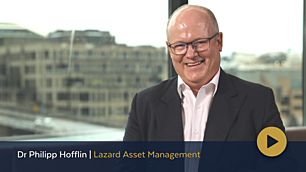Has the opportunity in Value stocks already passed?
Reddit stocks, SPACs, NFTs, Dogecoin - you name it, financial markets have grown increasingly strange over the past 2 years. Dr Philipp Hofflin of Lazard Asset Management, a markets veteran, was shocked by the enduring frothiness of markets.
"I managed money all the way through, from the Netscape float in '95 to the NASDAQ low in 2003. But the excesses we saw last year, probably top anything we saw back then... Extraordinary stuff."
Today, he believes that the rout of growth stocks and other speculative assets is only "30% through". This view is supported by analysis that tracks the median highest and lowest quintile forward price to earnings ratio of stocks in the ASX200 (below).
The chart shows that while valuations in high PE stocks have fallen considerably, they remain well above long term averages. Hofflin expects this unwind to continue for a few years and says it will be punctuated by some strong rallies in these high PE stocks.
So I don't think the straight line will continue, but there's a lot to go and it will probably take a couple of years to get there. - Dr Philipp Hofflin
Clearly sentiment towards high-growth names is cooling and a question now for many investors is where they can find goods returns in the market today. Value stocks (and managers) have had a strong start to 2022 but has the window of opportunity closed?
In the interview below, Hofflin expands on his views about the high PE stock unwind, explains why he believes there remains an opportunity in Value and shares two sectors that are presenting compelling opportunities on the ASX.
Watch the interview by clicking on the player below or read an edited transcript below.
Related content

.png)
Edited transcript
You recently shared a view that the sell-off in 'growth' was only 30% done. Can you explain your conclusion?
Good question. I'd probably update the estimate to 30 to 40% now. And I'll get in a moment to how I came up with that number. But I'd like to emphasise that it hasn't been just a switch into more cyclical sectors. It's really been much more about the unwind of the high, multiple stock bubble that had formed. And really when we think about what's been happening in 2022, we need to start of with where we were in 2021. And it's pretty clear now that 2021 was the peak of the US bubble if you will.
The froth that we saw in 2021 was just extraordinary.
I managed money all the way through, from the Netscape float in '95 to the NASDAQ low in 2003. But the excesses we saw last year, probably top anything we saw back then. Reddit stocks, SPACs, NFTs, Dogecoin, you name it. Bankrupt stocks filing to raise equity. Extraordinary stuff.
So we came off this enormous peak in the US, and we tracked several series in Australia to see how that's impacted the Australian market, and I show here one of them. That's one of the components that goes into our composite. And it shows there that the multiple for the lowest quintile P/E off the market, the 20% with the lowest forward multiples, and the top quintile, that's the quintile with the highest forward multiple stocks. And you can see how this bubble inflated over a number of years. You can actually, if you look very carefully, see how it responded to the Fed's pivot in early 2019, and then the rapid rise in multiples during COVID.
And it shows that, remarkably enough, in 2021, investors were paying more for the glamour stocks on the ASX than there were at the peak in March of 2000, quite extraordinary.
One of those rare times when a whole new generation of investors, and probably a couple of old ones who should know better, convinced themselves that it was easy, that there was a simple thematic way of making lots of money. Now, 50+ times earnings doesn't tend to end well. And it certainly started that way in 2022. And we saw that rapid unwind starting in this year. Now, the reason why we say that there's a fair way to go, is that on our composite, the mean reverse has only covered 30-40% of where we'd expect it to go when it goes back to normal.
Astonishingly enough, if you look, at that chart, the multiples peaked only in late 2021. We're only six odd months out from the peak of this. So value started performing in late 2020, but over 2021, that was really outperformance due to better EPS growth and despite ever-inflating multiples for the high P/E stocks.
So history suggests that this took a couple of years to inflate. Typically, it takes a couple of years to deflate. We've had entirely one-way traffic so far in 2022. I don't think that's going to continue either. Markets don't move in straight lines. In the tech wreck years, for example, there were several 30, 40% rallies in the NASDAQ in there, right? In fact, some of the biggest rises tend to come in bear markets, for all markets. So I don't think the straight line will continue, but there's a lot to go and it will probably take a couple of years to get there.
Are rising interest rates responsible for the sell-off in risk assets?
Well, I'd say yes and no. I mean, in the sense that it's absolutely the case that tighter financial conditions are detrimental to speculation and concept stocks and loss-making stocks and so forth. And it's playing an important part now.
I think what you're referring to is the fact that we believe that the bubble was going to pop one way or another. In other words, what happened in 2021 wasn't some rational duration effect that was entirely justified or anything like that. I mean, when you think of the last big tech boom, the NASDAQ peaked and US rates were over 5%, and it finally reached its bottom at a time when rates were below two.
So I think the lesson there is yes, loose money in fiscal policy really encouraged speculation, and then tightening can pop the bubble, but you can get bubbles without it, and they can pop without a tightening.
Has the opportunity in Value passed?
Our aggregate data shows that we are only sort of 30-40% through the adjustment, and again, you can see that from the chart that I referenced earlier. There's a fairly long way from 37 times to where typically these things bottom out at 17 times. That can really hurt. And all of that, by the way, presupposes that we go back to an environment such as what we've had for the last 25-30 years, that is, well-backed inflation, low-interest rates, and a 'Fed put'. If inflation generally is a problem then the multiple contraction will probably be much more severe. And like in the seventies, Value will probably do much better yet than we can even sort of conclude from the data that we have for the last 25 years.
Could you share some sectors and stocks that you believe offer value today?
In terms of sectors that we like, I'd like to call out two of them. One is the general insurance sector, and we are very large weighting in particular within that to QBE. Now, the thesis for QBE really comes from the fact that after a very long period where the global premium rate cycle was really bumping around the bottom for pretty much the better part of a decade, starting in 2019 there's been a very significant upswing. And that changes the underlying profitability clearly for these companies quite a lot. And QBE is a main beneficiary of that. Now, the way insurance accounting works, it doesn't flow through to the P&L immediately, because all these things are set by actuaries and they're smoothed and they increase provisions first and so forth. But you can see the benefits in the P&L in the balance sheet already.
Secondary is the fact that they do benefit from increases in interest rates, to the extent that they hold about 25 billion US dollars in technical reserve, then short term bonds. And of course, it's the yield on those rises. The profit goes up, for every hundred basis points, QBE's profit rises 15-20%.
And lastly, of course, it was the valuation that attracted us. The stock had a very difficult time for 10 years. And by the end of that, it's fair to say it was one of the most unloved stocks where everybody was incredibly critical and really had very low expectations, which is a great setup for future returns. So even today, and our stock has done already pretty well over the last 18 months, on the consensus earnings for 2024, so less than nine times. Pretty low multiple compared to some of the numbers we saw a moment ago.
I should add here that it is a balance sheet financial. So I think we spoke in the past about Computershare as a very pure way of getting leverage to rising rates. QBE does have a balance sheet. And if inflation were to be significantly higher for an extended period, I'm looking at 10 years or so, they would have to increase their reserves, but would also then flow through the P&L in terms of their better earnings. So we can quantify that, and it is a risk, but it's a manageable one. So it is a stock that we really like, and we also own some Suncorp and some AIG.
And the second sector I'd like to call out is just the energy sector that we've spoken about in the past.
You can learn more about the Lazard Select Australian Equity Fund by clicking on the Livewire fund profile below.

3 topics
3 stocks mentioned
1 fund mentioned
1 contributor mentioned

